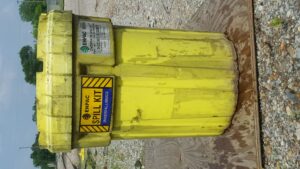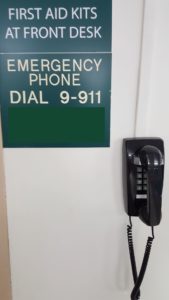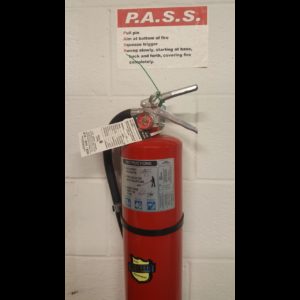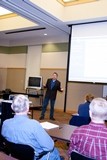Federal regulations of the U.S. Environmental Protection Agency (USEPA) at 40 CFR 262.17(a)(6) require a large quantity generator of hazardous waste (LQG) to comply with the preparedness, prevention, and emergency procedure standards of 40 CFR 262, subpart M. This article is the thirteenth (and final!) in a series that looks closely at each of the sections in subpart M to clearly describe the responsibilities of a LQG.
The purpose of this article is to address the requirements of 40 CFR 262.265 Emergency procedures
Before we begin…
These regulations were revised by the Generator Improvements Rule. If your state has not yet adopted the new rule you must continue to comply with the earlier version until it does. You may read an article explaining the earlier version of the regulations (prior to implementation of the Generator Improvements Rule) here.
|
Not sure of your hazardous waste generator status? |
Be aware the different sections of Subpart M (§262.250 through §262.265) are integrated with each other and contain requirements that form a whole known as: Preparedness, Prevention, and Emergency Procedures. This section (§262.265) is referenced earlier in §262.261 Content of contingency plan and §262.264 Emergency coordinator.
Scope and Applicability:
These regulations are applicable to a LQG. A small quantity generator of hazardous waste (SQG) is subject to entirely different requirements for emergency response. If you are a SQG please refer to this article for your version of these regulations: Preparedness, Prevention, and Emergency Procedures for Small Quantity Generator of Hazardous Waste.
As made clear by §262.250 (revised by the Generator Improvements Rule), the preparedness, prevention, and emergency procedures of Subpart M are applicable to those areas of a LQG where hazardous waste is generated or accumulated. This includes:
- Central Accumulation Area (CAA)
- Satellite Accumulation Area (SAA)
Read: Applicability of Preparedness, Prevention, and Emergency Procedures for LQG
|
Daniels Training Services, Inc. 815.821.1550 |
40 CFR 262.265 reads:
(a) Whenever there is an imminent or actual emergency situation, the emergency coordinator (or his designee when the emergency coordinator is on call) must immediately:
(1) Activate internal facility alarms or communication systems, where applicable, to notify all facility personnel; and
(2) Notify appropriate state or local agencies with designated response roles if their help is needed.
(b) Whenever there is a release, fire, or explosion, the emergency coordinator must immediately identify the character, exact source, amount, and areal extent of any released materials. The emergency coordinator may do this by observation or review of the facility records or manifests and, if necessary, by chemical analysis.
(c) Concurrently, the emergency coordinator must assess possible hazards to human health or the environment that may result from the release, fire, or explosion. This assessment must consider both direct and indirect effects of the release, fire, or explosion (e.g., the effects of any toxic, irritating, or asphyxiating gases that are generated, or the effects of any hazardous surface water run-offs from water or chemical agents used to control fire and heat-induced explosions).
(d) If the emergency coordinator determines that the facility has had a release, fire, or explosion which could threaten human health, or the environment, outside the facility, the emergency coordinator must report the findings as follows:
(1) If the assessment indicates that evacuation of local areas may be advisable, the emergency coordinator must immediately notify appropriate local authorities. The emergency coordinator must be available to help appropriate officials decide whether local areas should be evacuated; and
(2) The emergency coordinator must immediately notify either the government official designated as the on-scene coordinator for that geographical area, or the National Response Center (using their 24-hour toll free number 800/424-8802). The report must include:
(i) Name and telephone number of reporter;
(ii) Name and address of the generator;
(iii) Time and type of incident (e.g., release, fire);
(iv) Name and quantity of material(s) involved, to the extent known;
(v) The extent of injuries, if any; and
(vi) The possible hazards to human health, or the environment, outside the facility.
(e) During an emergency, the emergency coordinator must take all reasonable measures necessary to ensure that fires, explosions, and releases do not occur, recur, or spread to other hazardous waste at the generator’s facility. These measures must include, where applicable, stopping processes and operations, collecting and containing released hazardous waste, and removing or isolating containers.
(f) If the generator stops operations in response to a fire, explosion or release, the emergency coordinator must monitor for leaks, pressure buildup, gas generation, or ruptures in valves, pipes, or other equipment, wherever this is appropriate.
(g) Immediately after an emergency, the emergency coordinator must provide for treating, storing, or disposing of recovered waste, contaminated soil or surface water, or any other material that results from a release, fire, or explosion at the facility. Unless the generator can demonstrate, in accordance with §261.3(c) or (d) of this chapter, that the recovered material is not a hazardous waste, then it is a newly generated hazardous waste that must be managed in accordance with all the applicable requirements and conditions for exemption in parts 262, 263, and 265 of this chapter.
(h) The emergency coordinator must ensure that, in the affected area(s) of the facility:
(1) No hazardous waste that may be incompatible with the released material is treated, stored, or disposed of until cleanup procedures are completed; and
(2) All emergency equipment listed in the contingency plan is cleaned and fit for its intended use before operations are resumed.
(i) The generator must note in the operating record the time, date, and details of any incident that requires implementing the contingency plan. Within 15 days after the incident, the generator must submit a written report on the incident to the Regional Administrator. The report must include:
(1) Name, address, and telephone number of the generator;
(2) Date, time, and type of incident (e.g., fire, explosion);
(3) Name and quantity of material(s) involved;
(4) The extent of injuries, if any;
(5) An assessment of actual or potential hazards to human health or the environment, where this is applicable; and
(6) Estimated quantity and disposition of recovered material that resulted from the incident.
|
Daniels Training Services, Inc. 815.821.1550 |
Why the change?
Small changes:
- Replacement of the word “facility” or “owner or operator” with “generator” to emphasize the applicability of these regulations solely to a large quantity generator of hazardous waste (LQG).
- Replacement of “he” with a gender-neutral pronoun such as “emergency coordinator”.
- Some editing such as moving the text of a [Comment] to subparagraph (g) into the body of the subparagraph itself.
Immediate response to imminent or actual emergency:
The emergency procedures are divided into two types. The first is the immediate response to any emergency situation whether it is imminent (about to happen) or actual. During this immediate response it is acknowledged that the emergency coordinator may be on-call and may not yet be on site (read: The Requirements of 40 CFR 262.264 Emergency Coordinator for Large Quantity Generator of Hazardous Waste) therefore, either the emergency coordinator or his designee when he is on call must decide which – if either – of the following is necessary and immediately perform one or both – or neither:
- Activate internal facility alarms or communication systems, where applicable, to notify personnel within the facility. Read: The Requirements of 40 CFR 262.252 Required Equipment for Preparedness, Prevention, and Emergency Procedures at Large Quantity Generator of Hazardous Waste
- Notify appropriate state or local agencies if their help is needed. Read: The Requirements of 40 CFR 262.256 Arrangements with Local Authorities for Large Quantity Generator of Hazardous Waste
“Whenever there is a release, fire, or explosion…”
Here the regulations leave “imminent” emergencies (those that have not yet happened) behind and deal only with actual emergencies, e.g., release, fire, or explosion. Also unmentioned throughout the remainder of this section is the emergency coordinator’s designee. From here on out it’s all on the emergency coordinator. One thing that hasn’t changed is the requirement that actions be taken “immediately”.
First, the emergency coordinator must identify if there has been a release of a hazardous waste or hazardous waste constituent and if so, identify the following regarding the release:
- Its character.
- Its exact source.
- The amount of the release.
- The areal extent of the release.
Q: What is a release? How does it differ – if at all – from a spill?
A: To briefly summarize: a spill is something that does not come into contact with soil, water (surface or ground), or evaporate to the air either outside the boundaries of the LQG’s facility or outside the LQG’s control. A spill usually does not require the assistance of outside emergency responders and is usually not required to be reported. A release – no matter the amount – enters the soil, groundwater, or surface water and cannot be immediately recovered; or evaporates to the air. Any impact on the environment (a vapor cloud, a sheen on the surface of a body of water, discolored soil or dead vegetation) outside of the LQG’s facility boundary will be considered a release. Usually a release requires notification of outside agencies and the assistance of emergency responders.
To obtain information about the release the emergency coordinator may rely on any of the following:
- Direct observation.
- Review of facility records or manifests (aka: uniform hazardous waste manifest).
- Chemical analysis of the release (if necessary).
Note: this paragraph identifies three emergency situations (release, fire, or explosion) but then addresses the emergency coordinator response solely to a release. USEPA must feel the response to fires and explosions tend to be self-explanatory.
|
Interested in a Webinar that covers this topic, and more! |
“Concurrently…”
The emergency coordinator doesn’t just do one thing in an emergency. Concurrently (at the same time) as the above identification, the emergency coordinator must assess possible hazards to the following due to the release, fire, or explosion:
- Human health.
- The environment.
The emergency coordinator’s assessment must consider the following:
- Direct and indirect effects of the release, fire, or explosion.
- The effects of any toxic, irritating, or asphyxiating gases generated.
- The effects of any hazardous surface run-off from water or chemical agents used to control the fire.
- Heat-induced explosions.
 External Reports and Notifications:
External Reports and Notifications:
If the emergency coordinator determines the release, fire, or explosion could threaten human health or the environment (see just above) outside of the facility, the emergency coordinator must make the following reports / notifications:
Local Evacuation Necessary?
If evacuation of local areas is necessary, the emergency coordinator must immediately notify appropriate local authorities. Also, the emergency coordinator must be available to help the authorities decide whether local areas should be evacuated.
Notify Government Officials:
In addition to the notification of local authorities, the emergency coordinator must immediately (no time for assessment here) notify and report to one of the following:
- Government official designated as the on-scene coordinator for that geographical area.
- The National Response Center’s 24-hour toll free number (800.424.8802).
Q: Who is the government official designated as the on-scene coordinator for my geographical area?
A: The answer to that can be found in the Area Contingency Plan for your region (refer to this USEPA guide for developing an Area Contingency Plan). I suggest you start with your state environmental agency for answers and proceed to your USEPA regional office if your state is not able to assist you.
|
Interested in site specific training at your site that covers this topic, and more! Ask me about my Onsite Training |
The report must include the following:
- Name and telephone number of reporter.
- Name and address of generator. This is the large quantity generator (LQG).
- Time and type of incident. e.g., release, fire, or explosion.
- Name and quantity of materials involved to the extent known.
- The extent of injuries, if any.
- Possible hazards to human health or the environment outside of the facility.
Don’t Forget About Other Areas and Operations at the LQG During the Emergency!
In addition to all other duties, the emergency coordinator must take all reasonable measures necessary to ensure that the emergency (fire, explosion, or release) does not occur, recur, or spread to other hazardous waste at the facility. Measures that may be necessary include:
- Stopping processes and operations.
- Collecting and containing released hazardous waste.
- Removing or isolating containers.
Full stop!
If the generator stops operations while responding to the emergency, the emergency coordinator must monitor for the following where appropriate:
- Leaks
- Pressure buildup.
- Gas generation.
- Ruptures in valves, pipes, or other equipment.
|
Contact me the next time hazardous waste generator USEPA training is due to expire. |
The Emergency is over; now what?
Emergency response includes actions that must be taken after the emergency is over.
- Immediately after the emergency the emergency coordinator must arrange for the management of wastes generated during the response to the emergency. To do this, the generator must complete the hazardous waste determination. Newly generated hazardous waste is subject to all Federal and state hazardous waste regulations.
- The emergency coordinator must ensure no hazardous waste that may be incompatible with the released material (if there was a release) is treated, stored, or disposed of in the affected area of the facility until cleanup is complete.
- The emergency coordinator must ensure all emergency equipment listed in the contingency plan is cleaned and fit for use before the operations of the LQG are resumed.
- If an incident requires implementation of the contingency plan, the generator (this is not addressed solely to the emergency coordinator) must do both of the following:
- Note in the operating record the time, date, and details of the incident.
- Within 15 days after the incident submit a written report to the Administrator for the USEPA region of the LQG. Note: a written report may be required by your state in addition to or instead of the report to USEPA. Your state may have different criteria for submittal of a written report and may require it within a different time-frame.
- The written report to the Regional Administrator must include the following:
- Name, address, and telephone number of the generator.
- Date, time, and type of incident (e.g., fire, explosion).
- Name and quantity of material(s) involved.
- The extent of injuries, if any.
- An assessment of actual or potential hazards to human health or the environment, if applicable.
- Estimated quantity and disposition (what did you do with it?) of material recovered from the incident.
|
Contact me with any questions you may have about the generation, identification, management, and disposal of hazardous waste Daniels Training Services, Inc. 815.821.1550 |
Is that it?
No. First of all, as a LQG you must still comply with the remaining requirements of §262, subpart M which have been moved from their former location at §265, subpart D and were revised by the Generator Improvements Rule.
And then, what about training? At §262.17(b)(7) – directly following the referral to emergency procedures – are the training requirements for a LQG. §262.17(b)(7)(i)(C) reads in part:
At a minimum, the training program must be designed to ensure that facility personnel are able to respond effectively to emergencies…
So clearly, Hazardous Waste Personnel Training at a LQG is important.




